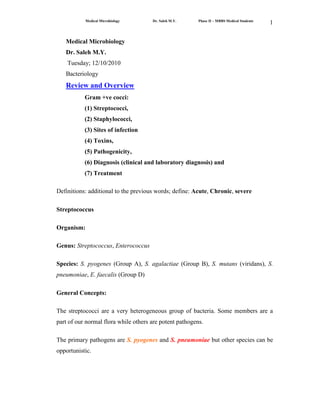
Bacteriology1 strept-phse ii-12-10-2010 -
- 1. Medical Microbiology<br />Dr. Saleh M.Y.<br /> Tuesday; 12/10/2010<br />Bacteriology<br />Review and Overview<br />Gram +ve cocci:<br />(1) Streptococci, <br />(2) Staphylococci, <br />(3) Sites of infection <br />(4) Toxins, <br />(5) Pathogenicity, <br />(6) Diagnosis (clinical and laboratory diagnosis) and <br />(7) Treatment<br />Definitions: additional to the previous words; define: Acute, Chronic, severe <br />Streptococcus<br />Organism: <br />Genus: Streptococcus, Enterococcus <br />Species: S. pyogenes (Group A), S. agalactiae (Group B), S. mutans (viridans), S. pneumoniae, E. faecalis (Group D) <br />General Concepts: <br />The streptococci are a very heterogeneous group of bacteria. Some members are a part of our normal flora while others are potent pathogens. <br />The primary pathogens are S. pyogenes and S. pneumoniae but other species can be opportunistic. <br />Group B streptococcus (S.agalactiae)Neonatal septicemia/meningitis CAMP testHippurate hydrolysis testGroup D streptococcusUrinary tract infection/ endocarditis Bile-esculin testEnterococci Non-enterococciLarge colonyMinute colony Viridans streptococciDental caries/endocarditis Group A streptococcus (S. pyogenes)Lancefield groupsHemolysis (alpha, beta, gamma)Bacitracin susceptibility test M, T, R proteinsStreptolysins O and SF protein/lipoteichoic acidRheumatic fever/carditis/arthritisGlomerulonephritisScarlet feverToxic shock-like syndrome/bacteremia“Flesh-eating bacteria”Pyrogenic toxinErythrogenic toxin<br /> <br />Streptococcus pneumoniae and its infection site<br />Streptococcus pyogenes and its infection site<br />For example:<br />S. agalactiae can produce severe neonatal disease including: <br />meningitis, pneumonia and bacteremia in infants aged 7 days up to 3 months <br />S. faecalis (E. faecalis) may be implicated in endocarditis and urinary tract infections.<br /> S. mutans is an important contributor to dental caries. <br />The streptococci are generally delineated into groups according to the Lancefield method. <br />As important as the acute diseases produced by these microorganisms are the later sequelae of Group A streptococci. These sequelae include i) rheumatic fever following respiratory infections and ii) glomerulonephritis following skin infections. <br />Distinctive Properties: <br />Streptococci are Gram-positive, non-motile cocci that divide in one plane, producing chains of cells. S. pneumoniae is a lancet-shaped diplococcus (formerly genus Diplococcus). <br />The streptococci are catalase negative (unlike Staphylococcus) and may be either facultative or obligate anaerobes. <br />Hemolysis (alpha, beta) on blood agar is an important differential characteristic. <br />Lancefield groupings are based on the serology of cell wall polysaccharides (18 groups were originally established by Rebecca Lancefield). <br />The M proteins of group A serve as important virulence factors that help the organism resist phagocytosis. <br />Lipoteichoic acids (LTA) mediate attachment to epithelial cells. <br />Many antigenic moieties on the streptococcal cell surface resemble human muscle and connective tissue and these similarities may be responsible for the late sequelae. For example, S. pyogenes membrane Ags resemble cardiac, skeletal, smooth muscle, heart valve fibroblasts and neuronal tissue. <br />The capsule of S. pyogenes is composed of hyaluronic acid (like host connective tissue) so it is non-antigenic while the capsule of S. pneumoniae is very antigenic and is its sole virulence factor. <br />Toxins produced by streptococci include: streptolysins (S & O), NADase, hyaluronidase, streptokinase, DNAses, erythrogenic toxin (causes scarlet fever rash by producing damage to blood vessels; requires cell to be lysogenized by phage that encodes toxin). <br />Pathogenesis: <br />S. pyogenes is the leading cause of bacterial pharyngitis and tonsillitis. It may also produce sinusitis, otitis, arthritis and bone infections. Some strains prefer skin, producing either superficial (impetigo) or deep (cellulitis) infections. <br />S. pneumoniae is the major cause of bacterial pneumonia in adults. Its virulence is dictated by its capsule. <br />Post-infection sequelae of S. pyogenes occur 1-3 weeks after acute disease. These sequelae include i) acute rheumatic fever (following pharyngeal infections) and ii) glomerulonephritis (following either pharyngeal or skin infections). These sequelae may be due to an altered immune response (autoantibodies). Glomerulonephritis results from deposition of Ag:Ab complexes on basement membrane of kidney glomeruli. <br />Other species/groups include: <br />Group B strep (e.g. S. agalactiae) most often produce disease in animals but are also the leading cause of neonatal septicemia and meningitis. <br />Group D strep (e.g. E. faecalis) produce urinary tract infections and endocarditis. <br />Viridans species (e.g. S. mutans) are responsible for oral caries and subacute bacterial endocarditis following dental surgery. <br />Anaerobic streptococci may cause genital, brain or abdominal infections. <br />Host Defenses: <br />The normal host resists streptococcal infection; they are often secondary invaders. <br />The capsule of S. pyogenes is poorly immunogenic; anti-M protein Abs are important in host defense. <br />The capsule of S. pneumoniae is very immunogenic; anti-capsule Abs are opsonizing, enhancing phagocytosis. <br />Pneumococcal infections occur most often in debilitated persons (alcoholics, elderly, those with underlying disease). <br />Epidemiology: <br />These organisms are widely distributed in nature. <br />Five to 15% of normal healthy individuals carry S. pyogenes. <br />Carriage of S. pneumoniae (a solely human organism) is age dependent: <br />Age% CarriageLess than 5 40%5 to 9 30%10 to 15 17%adults 6%adults with children 25%<br />Streptococci are labile organisms that require close personal contact for transmission; S. pyogenes respiratory disease peaks at 6 and 13 years old, showing a seasonal pattern (late winter, early spring). <br />Diagnosis: <br />Clinical: Diagnosis based solely upon symptomology is often not possible. <br />Laboratory: To confirm the presense of S. pyogenes, throat swabs are used. For S. pneumoniae, sputum or blood samples are taken. The specimens may then be plated on blood agar for isolation of Gram-positive, catalase-negative cocci. Useful characteristics for differentiation include the pattern of hemolysis, bacitracin resistance or sensitivity and optochin resistance or sensitivity. Immunologically-based rapid test kits are often employed. <br />Control: <br />Sanitary: Since Streptococcus is a labile organism, close contact is required for spread; hence, avoiding contagious contacts can prevent disease. <br />Immunological: Pneumococcal vaccines are available for persons at high risk, particularly the elderly. <br />Chemotherapeutic: Penicillin is the drug of choice for S. pyogenes and S. pneumoniae, when the organisms are susceptible. Chemotherapy is given over a 10 and 7-145 days regimen, respectively. Group D streptococci are resistant to many antibiotics. Life long prophylaxis (low dose penicillin) is recommended for rheumatic fever patients. <br />
